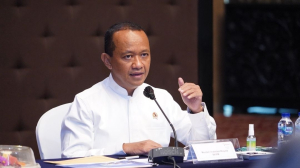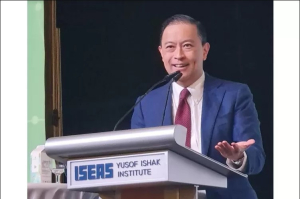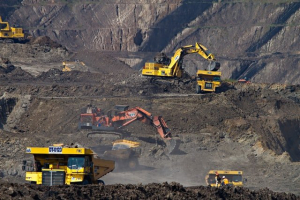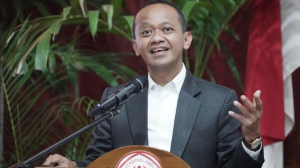Fighting at the grassroots, not on stage: Jatam
Amidst noisy narrative of green energy, clean energy transition, and booming nickel industry − the backbone of the world's electric vehicles − the Mining Advocacy Network (Jatam) continues to speak up from the margins.
It is known not for the frenzy of campaigns or major media coverage, but for its radical and consistent support for the masses directly impacted by mining and the expansion of the extractive industry.
Jatam is not just an NGO. It is a network, a movement. More importantly, it is an arena of resistance spreading from village to village, from hamlet to hamlet, and was not born out of international seminars or donor forums.
"We are not an NGO that is busy looking for projects. We are a movement. We are not a place for activists to seek a stage," Melky Nahar, National Coordinator of Jatam, spoke to Indonesia Business Post at its cozy culinary stall in South Jakarta on April 16, 2025.
"What we are building is not an organizational structure, but an infrastructure of resistance. If villagers fight against mining operation in a region, there is no Jatam name at the front. What appears is their village name. That is the most important thing."
Melky emphasized that all movements must start from perspective. "If you don't have perspective, you will be easily diverted. A donor comes, you join. Whenever there is a new project, you change course. At the end, you don't know where you stand," he said.
For Jatam, their struggle is not just about saving thenature or rejecting mining operation. This is an ideological struggle, about social justice, about people's sovereignty over their living space, and about questioning the big idea of economic growth that has so far been used as an excuse to seize people's land.
“Most of our people have been fed by the idea that progress means industry. Prosperity means mining. In fact, when you meet the people of Wawonii [Southeast Sulawesi], for example, they calculate the wealth of one cashew tree in their own way. Tree productivity is 60 years and one tree can be worth millions of rupiah. But then a mining company comes, giving compensation of Rp5,000 per tree felled. That's called robbery,” Melky said.
Iman Shofwan, Head of Jatam's Node and Network division, confirmed that Jatam's strength lies in the villages they assist. In their work, each issue is traced based on the actual conflict map. Who is being targeted? Where is the location of the new concession? What are the strengths of the residents there?
“We study all of that first. If the residents have strength in their village area, we strengthen the resistance there. If they are ready to campaign, we help with data and strategy. If the gap is in investors or funders, we attack from there. So we don't work based on trends, but on field needs,” he said.
Behind all of this, there is a principle that Jatam maintains: they do not accept funds from donor institutions affiliated with countries or large corporations. “We are probably the poorest NGO in Indonesia,” Melky said laughing. “But people who join are not money-oriented. They know that it is about their village. If you want projects, get out of here.”
Between China and America
With the increasingly fierce struggle for nickel, a critical mineral for battery and electric vehicle industries, Jatam is often accused of being part of a trade war scheme between major countries. In fact, they are frequently considered a tool of the West to attack China’s investment dominance in Indonesia’s mining sector.
“We go against their [America’s and China’s] will as they only care about their strategic interests. Not about the climate, nor the people,” Melky emphasized.
He cited that in 2015, Jatam was even invited by the Chinese government to a forum to provide an assessment on the Belt and Road Initiative program. “But, we ended up openly condemning the program in the forum,” Melky said.
Meanwhile, Iman concluded that many companies now use “clean energy” label only as cosmetics. He cited that big players in the renewable energy sector, such as nickel and geothermal, are those who used to be successful in coal mining.
“Just check the owners of nickel smelters today. Many used to be in coal mining. They just shifted their portfolio. The narrative is still about the environment. They say they care about the climate, but coal-fired power plants (PLTU) continue to operate and coal production actually increases every year. So in our opinion, it’s all about business expansion, not energy transformation,” he said.
The Indonesian government itself, according to Jatam, continues to use the labels “energy transition” and “green energy” to deceive the public.
“We are constantly being lulled by the meaningless green narrative, while people around the mines are the ones being sacrificed,” Iman said.
“The ‘green’ and ‘low-carbon’ labels which are often used to characterize energy policies or products are often considered as an effort to relieve public pressure without any real commitment to structural change,” he added.
In practice, energy industry expansion continues by maintaining projects that have the potential to damage the environment in order to serve the needs of large industries. Policies related to green and low-carbon energy are often used as a tool to “deceive” the public, by attaching environmental labels that have no real impact on the ground.
Energy commitments
Minister of Energy and Mineral Resources, Bahlil Lahadalia, once questioned major power’s environmental preservation commitment. He even openly stated that if America could withdraw from the Paris agreement, what can then be expected from smaller countries? Further, many policies only increase the exploitation of natural resources without paying attention to the economic welfare of small communities.
Is this environmental and climate change campaign more aimed at public awareness or at influencing consumers and investors?
In many cases, the strength of the campaign lies on how far the communities or local groups can move to influence policy.
For Jatam, the power to influence decisions often focuses on investors or parties with economic interests in energy projects. If a company or country is committed to switching to renewable energy but continues to fund coal projects, then the campaign can be directed at exposingthe incompatibility to investors who could be unaware of this contradiction.
However, it does not only depend on strategies that pressure external parties, but also on mobilizing local communities. "An effective campaign must involve people at the grassroot level, strengthen local solidarity, and ensure that communities directly affected by the policy have a voice in decision-making process," Melky said.
Already have an account? Sign In
-
Start reading
Freemium
-
Monthly Subscription
20% OFF$29.75
$37.19/MonthCancel anytime
This offer is open to all new subscribers!
Subscribe now -
Yearly Subscription
33% OFF$228.13
$340.5/YearCancel anytime
This offer is open to all new subscribers!
Subscribe now







